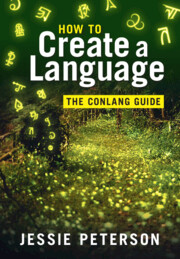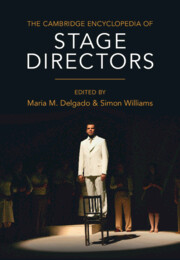Refine search
Actions for selected content:
565 results
Chapter 22 - ‘A curious creature from the market’
- from Part IV - Worlds of Print
-
-
- Book:
- African Literature in Transition
- Published online:
- 23 October 2025
- Print publication:
- 06 November 2025, pp 427-444
-
- Chapter
- Export citation
Chapter 11 - Linguistic Cohabitation and the Equivalences of Print
- from Part III - New Genres
-
-
- Book:
- African Literature in Transition
- Published online:
- 23 October 2025
- Print publication:
- 06 November 2025, pp 221-237
-
- Chapter
- Export citation
2 - Translation
- from Part I - Introduction and Translation
-
- Book:
- The Gospel of Truth
- Published online:
- 23 October 2025
- Print publication:
- 06 November 2025, pp 20-42
-
- Chapter
- Export citation

How to Create a Language
- The Conlang Guide
-
- Published online:
- 23 October 2025
- Print publication:
- 02 October 2025
-
- Textbook
- Export citation
Chapter 11 - Bloomsbury and Russomania
- from Part II - Global Bloomsbury
-
-
- Book:
- A History of the Bloomsbury Group
- Published online:
- 09 October 2025
- Print publication:
- 23 October 2025, pp 171-186
-
- Chapter
- Export citation
15 - Language Use in Chaucer’s Canterbury Tales
- from Part II - Lighthouse Works and Authors
-
-
- Book:
- The New Cambridge History of the English Language
- Published online:
- 18 October 2025
- Print publication:
- 16 October 2025, pp 371-384
-
- Chapter
- Export citation
Introduction
-
- Book:
- God, Slavery, and Early Christianity
- Published online:
- 19 September 2025
- Print publication:
- 09 October 2025, pp 1-47
-
- Chapter
- Export citation
17 - Translation
- from Part III - Expanding Features
-
- Book:
- How to Create a Language
- Published online:
- 23 October 2025
- Print publication:
- 02 October 2025, pp 380-394
-
- Chapter
- Export citation
Chapter 15 - Long Ago
- from Part III - In the Name of Time
-
-
- Book:
- Michael Field in Context
- Published online:
- 03 October 2025
- Print publication:
- 25 September 2025, pp 135-143
-
- Chapter
- Export citation
Chapter 7 - Tragedy
- from Part I - Forms and Genres
-
-
- Book:
- The Cambridge Companion to Modernist Theatre
- Published online:
- 28 August 2025
- Print publication:
- 11 September 2025, pp 126-143
-
- Chapter
- Export citation
Translating French mathematics and lobbying the horse-drawn carriage trade (USA, 1869–1877)
-
- Journal:
- Science in Context , First View
- Published online by Cambridge University Press:
- 08 September 2025, pp. 1-26
-
- Article
- Export citation
Local Patterns of Relic Veneration in Late Antiquity: Reassessing Alleged Distinctions between Greek and Roman Customs
-
- Journal:
- Church History , First View
- Published online by Cambridge University Press:
- 27 August 2025, pp. 1-21
-
- Article
- Export citation
Chapter 16 - Translation and Adaptation
- from Part II - Theatre
-
-
- Book:
- María Irene Fornés In Context
- Published online:
- 27 August 2025
- Print publication:
- 07 August 2025, pp 171-180
-
- Chapter
- Export citation
Native Chinese readers activate English translations of words during Chinese sentence reading
-
- Journal:
- Bilingualism: Language and Cognition , First View
- Published online by Cambridge University Press:
- 06 August 2025, pp. 1-12
-
- Article
-
- You have access
- Open access
- HTML
- Export citation
2 - Stereotyped Knowledge
-
- Book:
- Selling Sexual Knowledge
- Published online:
- 24 June 2025
- Print publication:
- 10 July 2025, pp 57-89
-
- Chapter
-
- You have access
- Open access
- HTML
- Export citation
The Translation Machine: Exploring the Infrastructures of Valorization under Semiocapitalism
-
- Journal:
- Signs and Society / Volume 13 / Issue 3 / September 2025
- Published online by Cambridge University Press:
- 08 July 2025, pp. 311-325
-
- Article
-
- You have access
- Open access
- HTML
- Export citation
The Counting Machinery: Translation, Multiplication, and Liberal Politics of Homelessness in Paris
-
- Journal:
- Signs and Society / Volume 13 / Issue 3 / September 2025
- Published online by Cambridge University Press:
- 08 July 2025, pp. 431-453
-
- Article
-
- You have access
- Open access
- HTML
- Export citation
Introduction
-
-
- Book:
- Latinx Literature in Transition, 1992–2020
- Published online:
- 19 June 2025
- Print publication:
- 03 July 2025, pp 1-22
-
- Chapter
- Export citation
Chapter 6 - Global Wanderings
- from Part I - Shifting Coordinates
-
-
- Book:
- Latinx Literature in Transition, 1992–2020
- Published online:
- 19 June 2025
- Print publication:
- 03 July 2025, pp 113-132
-
- Chapter
- Export citation

The Cambridge Encyclopedia of Stage Directors
-
- Published online:
- 19 June 2025
- Print publication:
- 03 July 2025
